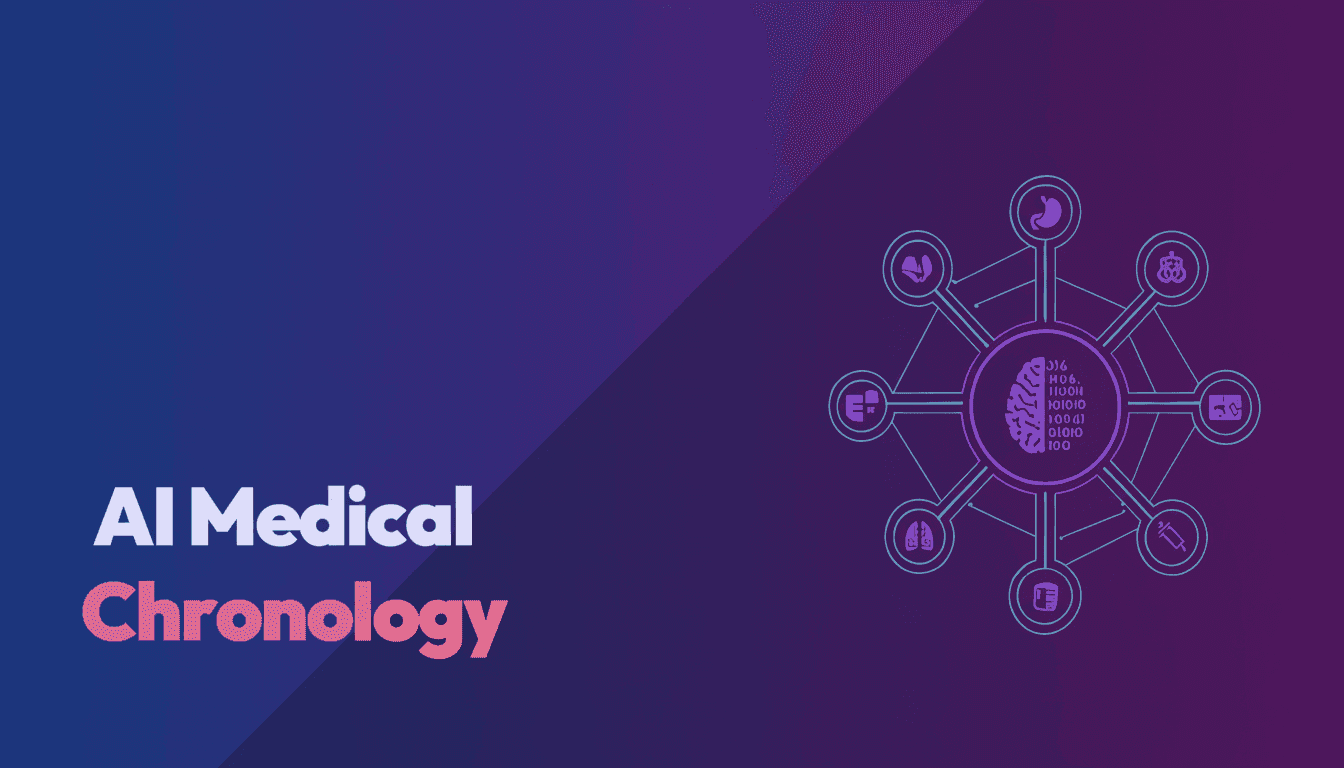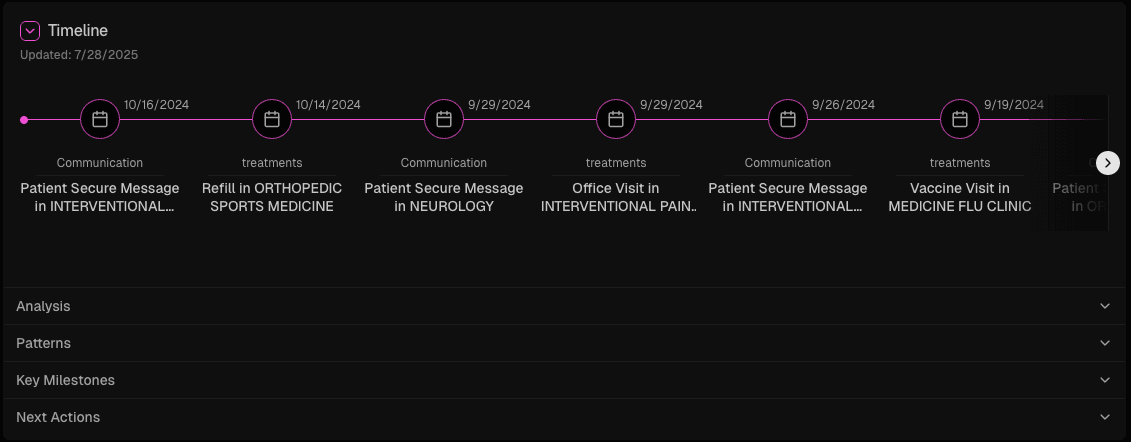
How to Create an AI Medical Chronology for Insurance Claims
Turn Medical Records into Precise Timelines for Claims Teams Using Medical Chronology AI
Understanding medical events in their proper sequence is foundational for insurance claims processing.
Workers' compensation claims, disability assessments, and long-term care evaluations all hinge on building clear timelines of medical treatments, diagnoses, and recovery progress.
With the complexity of manually sorting through hundreds of documents from varied sources, claims adjusters spend weeks dissecting physician notes, hospital discharge summaries, diagnostic reports, therapy records, and more.
All this extra time and effort in assembling medical chronologies hinders claims adjusters from making fast & fair decisions because of bottlenecks that delay claims resolutions and the risk of overlooking critical details.
Claims & investigations teams can benefit from AI medical chronologies systems that transform their operations by automatically organizing medical information into precise, time-sequenced narratives with evidence-backed citations.
This article explains what AI medical chronologies achieve in claims operations, how they differ from traditional approaches, how this technology is precise & efficient, and the strategic advantage these tools offer claims executives looking to enable their teams.
What Is an AI Medical Chronology?
To start, what are AI-generated medical chronologies for claims teams and how do they differ from AI medical summaries?
AI for claims processing encompasses medical chronologies, medical summaries, and many more applications.
However, while AI medical-records summaries create concise representations of relevant information based on data extraction & analysis, medical chronology AI establishes an accurate & extensive sequence of medical events over time.
Medical-record summaries are comprehensive overviews that highlight key diagnoses, treatments, and outcomes relevant to evaluating claims.
AI medical chronologies visually organize pertinent information, revealing how conditions developed, how treatments progressed, and where gaps in care occurred. These detailed, sequential timelines paint a complete picture of a claimant’s healthcare journey.
Medical chronology AI differs from simpler document-organization tools by understanding medical terminology, recognizing patterns in treatment progression, and identifying temporal relationships between different healthcare events.
The chronological approach is valuable for complex cases involving:
- Workers' Compensation Claims: Understanding injury progression, from initial incident through treatment completion and return-to-work assessments, requires claims teams to precisely map medical interventions and recovery milestones.
- Disability Evaluations: Long-term disability claims depend on establishing timelines that demonstrate functional limitations over specific periods and responses to various treatment approaches.
- Ongoing Medical Management: Cases requiring extended care use chronological analysis to track treatment effectiveness and identify helpful interventions.
With AI medical-chronology services, adjusters, investigators, and lawyers can use AI to generate comprehensive visual timelines of medical events in a chronological view to understand the sequence and context of each claim when making determinations.
AI medical chronology extracts data from documents and, on a timeline, displays injury details, doctor visits, diagnostic reports, recovery notes, and more, explaining context and linking facts to source files to help teams better understand complex claims.
How Claims Teams Currently Build Medical Chronologies
Claims adjusters traditionally create medical chronologies through multi-step manual processes that require extensive research, confirming sources, organizing documents, mapping events, making updates, and several rechecks.
It’s work that can only be carried out by detail-oriented, persistent subject-matter experts:
- Manual Review and Extraction: Adjusters study claims documents, including physician notes, lab results, and imaging reports, extracting dates, treatments, and diagnoses to understand medical terminology and identify impactful details.
- Chronological Mapping: Adjusters manually arrange extracted information in chronological order, cross-referencing multiple sources to resolve date conflicts and ensure treatment sequences make clinical sense.
- Gap Identification: Teams review completed chronologies to identify missing medical records, treatment gaps, or unexplained medical updates that require further investigation.
- Documentation and Updates: As new medical information becomes available, adjusters manually update chronologies, revising timelines to ensure consistency across all documentation.
Resource Requirements for Manual Chronology Creation
According to one study, nearly half of claims professionals spend 30%–40% or more of their time on routine tasks, like searching for documents and recreating lost information.
For creating medical chronologies, this intensive process requires specialized training in medical terminology & documentation standards, quality control to review chronologies for accuracy & completeness, and coordination between multiple teams.
These resource demands create operational constraints at a time when claims volumes are increasing and healthcare documentation is growing more complex.
How AI Medical Chronology Is Different
Modern AI medical chronologies represent a leap forward for claims teams, freeing them from tedious tasks so they can understand the full medical history of a claim to make faster & fairer decisions.
But how does AI generate medical-chronology reviews with speed and precision to enable insurance teams?
AI document-processing ingests claims data, leveraging a custom-curated vision-language model to understand context and present medical events visually in chronological order, with explanations and citations to help investigators internalize complex claims details with ease.
AI Document-Processing for Medical Chronologies
Below are the steps for how Owl.co reads & understands claims documents to create medical chronologies for claims teams with advanced precision using vision-language models (VLMs) specifically trained for medical-documentation analysis.
1. Initial Document-Processing
The first stage of processing claims info for medical chronologies involves optical character recognition (OCR) to extract basic text from both medical documents.
OCR scans & transforms text into machine-readable data, but it struggles on its own with handwritten physician notes, faded medical charts, and complex document layouts common in medical records.
That's because OCR is insufficient for understanding hard-to-read text and it doesn’t understand context. That’s why Owl.co augments the document-understanding process with vision-language models.
2. Custom VLMs
After initial text extraction, Owl.co's document-processing tool for insurers, OwlVision, includes custom-curated VLMs trained specifically to understand medical documentation, to analyze documents with precision.
Unlike a tool that simply reads text, OwlVision understands context by analyzing both textual content and visual elements, such as document structure, positioning, and formatting.
3. Contextual Understanding
OwlVision analyzes a text's position on the page to understand relationships between different data points.
For example, it recognizes that a date appearing next to a diagnosis in a specific section indicates when that diagnosis occurred, while the same date in a different location might indicate when symptoms first appeared.
4. Vector Representation and Entity Mapping
OwlVision then creates mathematical representations (vectors or "word clouds") that capture the semantic meaning of medical concepts.
These vectors represent the relationships between entities to connect, for example, specific medications with dosage dates, symptoms with diagnoses, and healthcare providers with treatments.
5. Temporal-Relationship Analysis
Lastly, to create AI medical chronologies, OwlVision identifies temporal markers to establish chronological relationships between medical data, like recognizing implicit time relationships (“two weeks after initial presentation” or “following discharge”) for accurate sequences.
Data Organization and Fact-Based Insights
To understand a claim quickly and confidently, teams should also depend on fact-based evidence and clearly delineated data in AI medical chronologies.
Medical chronologies in OwlVision feature claims insights centrally or organized by category, such as conditions, lab reports, medical visits, medications, or procedures. And all insights link back to sources with citations for auditability and reliability.
Together, clean data organization and evidence-based insights create medical chronologies with human-centric AI, enabling claims adjusters, investigators, and lawyers to leverage their creativity and intuition instead of exhausting time on scouring data and making charts.

Here's an example of an AI medical chronology for claims teams, inclusive of dates that reference to cited insights alongside curated, expanded drop-downs that explain context about medical details.
How AI Medical Chronologies Impact Claims Operations
Medical chronology AI benefits multiple departments across the entire claims processing operations.
Claims Processing Excellence
Studies about claims for workers' compensation indicate that about one-third of all adjusters have average caseloads 14% higher than the recommended maximum and 68–152% higher if dealing exclusively with complex claims.
Instead of spending weeks manually organizing medical records, AI medical chronologies provide adjusters with comprehensive timelines almost instantly.
This streamlined workflow, powered by AI document automation for insurance, reduces their workload, giving them more time to spend on individual cases.
The AI identifies patterns for adjusters, such as whether claimants followed prescribed treatment plans, responded appropriately to interventions, or experienced unique complications.
Enhanced Fraud Detection
Research indicates that fraudulent medical claims contain chronological inconsistencies and pattern anomalies that AI can quickly spot, especially with medical chronologies.
This chronological view often reveals suspicious patterns such as claimants receiving treatments for conditions before officially being diagnosed, or claiming disabilities that don’t align with documented medical improvement.
This benefit from AI medical chronologies enables investigators to flag cases and detect fraud in insurance claims.
Legal Support
AI medical chronologies benefit lawyers at insurance companies by offering accountability through audit trails, effectiveness via deterministic analysis, and ethical standards through evidence-based conclusions.
In Owl.co, AI medical chronologies services are transparent and defensible with detailed documentation and direct citations for explainable AI in insurance, building the comprehensive audit trails necessary for litigation and regulatory compliance.
The reliability of the advanced document-processing technology, with features like data organization and AI document classification for insurance, helps legal professionals quickly access and verify that information remains consistent across all documentations.
AI Medical Chronologies with Claims Intelligence
AI medical chronologies deliver accuracy, efficiency, and insights to elevate modern claims operations, producing successful outcomes for all stakeholders — from claims teams who can take on more meaningful work to genuine claimants who receive faster, fairer resolutions.
The technology underlying medical chronologies is a part of a larger framework called Claims Intelligence, which combines powerful AI with precise knowledge for claims adjusters.
AI medical chronologies part of Claims Intelligence help insurance executives to champion human expertise in claims decisions, empowering them to transform insurance.
Ready to try out AI medical chronologies? Book a demo to explore our AI toolkit for insurance.
